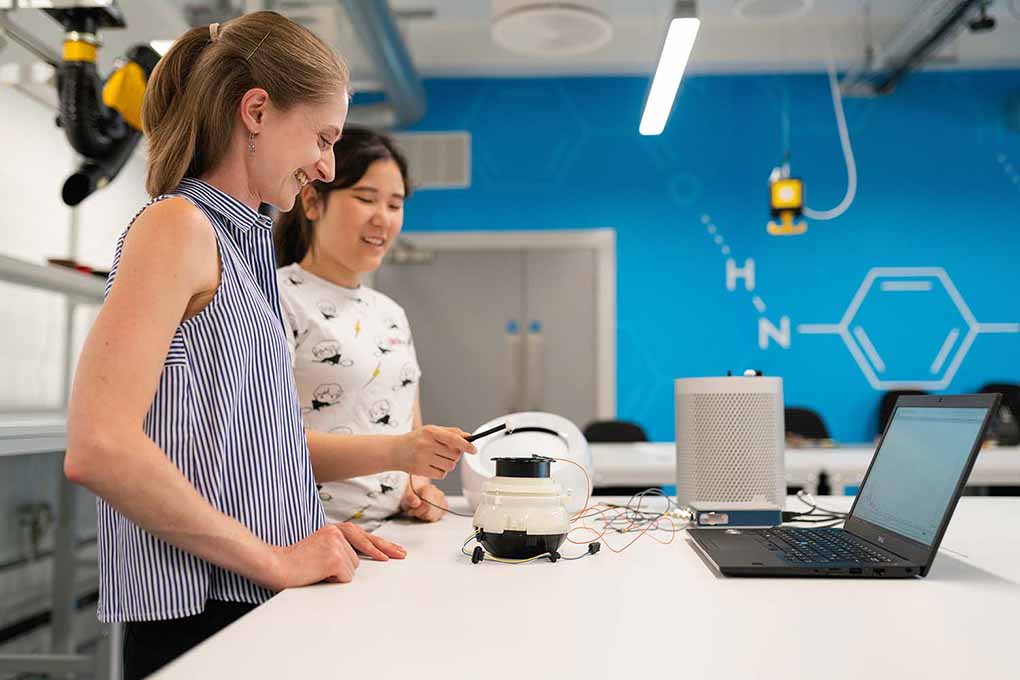Women in STEM
Historically, economic growth has often been driven by discoveries in science, technology, engineering and mathematics. Today, people who are working in STEM are vital in solving global problems such as climate change or making leaps in innovation such as integrating AI into society.
Every organisation in Australia is reliant on STEM skills to thrive but they all need to address the significant under-representation of women in STEM. In the face of a skills shortage, all the nation’s available talent needs to be utilised.

In this blog, we will discuss:
- Why is STEM important to every economy?
- What is the current job market in STEM?
- What is the current situation of women in STEM? and
- How should we respond?
Why is STEM important to every economy?
The world is living in the Fourth Industrial Revolution (also known as Industry 4.0), an age where digital technology increasingly becomes integrated into our lives. According to the Gist, having a qualified STEM workforce that has skills in areas such as biotech or information technology is the best response to the ever-evolving digital revolution.
STEM skills are now required for around 75% of jobs in the world’s fastest-growing industries and a strong STEM workforce will provide Australia with a competitive advantage in our main exports such as agriculture and optimising healthcare for all.
-PricewaterhouseCoopers International Limited (PWC)
GDP would rise by 57.4 billion over 20 years if just 1% of Australia’s workforce changed into STEM roles.
What is the current job market in STEM?
The demand for STEM skills is very high and will continue to grow to address the needs and challenges of a digitally connected world. Between 2021 to 2026, the National Skills Commission predicts that jobs in STEM will grow by 14.2% which is twice as fast as non-STEM jobs (7.4%). STEM careers are also attracting salaries well above the national average in Australia.
The survey conducted by Deloitte Access Economics for the Office of the Chief Scientist found that over 82% of employers value STEM qualifications in the workplace. The STEM capabilities they value the most are active learning, critical thinking, and complex problem-solving skills.
What is the current situation of women in STEM?
Global Recognition
The United Nations has written 17 Sustainable Development Goals for their 2030 Agenda. Goal number 5 is about gender equality and includes enhancing the use of enabling technology, in particular, information and communications technology to promote the empowerment of women and use Industry 4.0 for the public good. The ability of women to access, develop and influence science, technology and innovation will directly influence whether we achieve gender equality on a global scale.
Global Statistics
The 2021 UNESCO Science Report in their chapter entitled ‘To be smart the Digital Revolution will need to be inclusive’ found that women only accounted for 28% of engineering graduates and 40% of computer science and informatics graduates. Women accounted for 44% of PHDs but only 33% of researchers.
The World Economic Forum’s Global Gender Gap report stated that only 1 in 5 professionals in complex fields such as artificial intelligence is a woman (i.e. 22%). The good news is that companies are recognising the benefits of having a diverse workforce such as investor confidence and higher profit margins. The Gender Gap report estimates that closing the gender gap by 25% could add around US$5.3 trillion to the global gross domestic product (GDP).
Globally, women of start-ups still struggle to access finance and women in large tech companies are under-represented in leadership and technical roles. Women are more likely to leave STEM roles due to poor career prospects, gender bias and stereotyping, job insecurity, gender pay gap and inflexible working arrangements.
Audrey Azoulay, UNESCO Director-General
Even today, in the 21st century, women and girls are being sidelined in science-related fields due to their gender. Women need to know that they have a place in science, technology, engineering and mathematics, and that they have a right to share in scientific progress.
Australian Statistics
According to the STEM Equality Monitor for 2022, women only make up:
- 36% of enrolments in university STEM courses and just 16% of enrolments in vocational STEM courses.
- 27% of the workforce across all STEM industries.
- 23% of senior management and 8% of CEOS in STEM-qualified industries.
Although the gender pay gap has shrunk, women still earn 18% less than men across all STEM industries.
According to the 2020 report by the Office of the Chief Scientist a lack of diverse female role models in STEM further decreases girl’s and women’s likelihood of persisting in STEM education and considering STEM as a career option. Female students are participating in STEM education at significantly lower rates than male students. Completion of tertiary STEM education is much lower for women at 20.8% while for men it is 79.2%.
How should we respond?
1. Remove barriers at every point
We need to remove barriers to participation at every point of the STEM pipeline.
Primary school and high school
Exposure to STEM at a young age through programs designed to feed children’s curiosity for science, technology, and maths will be effective in encouraging girls to pursue a career in STEM.
Teachers and parents can influence students greatly and need to be provided with resources that highlight STEM as a possible career choice for girls, not just boys.
University
Women need to be given opportunities during their studies to use their STEM skills to prepare them for their careers. It is important that universities can connect women to mentoring programs such as the STEAM Ahead Program and Women Who Code who help women launch their careers through development and networking opportunities.
Work
In the workplace, employers of STEM professionals must remove obstacles and biases that discourage women to remain in STEM careers. This includes instilling a culture where gender discrimination and bullying will not be tolerated and implementing flexible work options. Connecting women with women STEM experts will allow young women the chance to be mentored and progress in their careers.
2. Government initiatives
It is essential that governments invest in programs that encourage girls and women to pursue an education and career in STEM industries. Some of the initiatives in Australia are:
- Advancing Women in STEM Strategy action plan - details how the government will partner with the STEM sector and advocate for gender equity.
- Women in STEM Decadal Plan – guides stakeholders to identify and implement actions to build a strong STEM workforce.
- Superstars of STEM program - supports STEM experts to become visible media and public role models.
- Women in STEM Ambassador – led by Professor Lisa Harvey-Smith to influence and mobilise Australia’s business leaders, educators, and policymakers to increase the rate of participation of girls and women in STEM.
- Elevate program – scholarships (up to 500) awarded to women in STEM over 6 years.
- Girls in STEM Toolkit – educates girls, parents, and teachers on the opportunities and careers in STEM that can arise and break down gender stereotypes.

3. Include women in the conversation
Women need be involved in the critical conversations and developments of future technology to ensure their needs and perspectives are included in the design of new products that impact our daily lives such as smartphone apps and AI.
Gretchen Scott, Founder of Tech Diversity Lab, believes that “technology should be created by a group of people that represent the people it's meant to be serving.”
Women need to be heard more in the media and invited to speak at scientific conferences, universities and government forums. The Request a Woman in STEMM directory is a network of women scientists that can be consulted and collaborated with or be invited to speak at an event.
4. Celebrate and inspire
Prestigious awards and prizes that showcase the excellence of women in science need to be promoted and celebrated. Examples include the L’Oreal-UNESCO for Women in Science which has recognised more than 3400 talented female scientists in over 110 countries and OWSD-Elsevier Foundation Awards for Early-Career Women Scientists in the Developing World.
February 11 is the International Day of Women and Girls in Science and highlights the critical role that women and girls have in science and technology and that their participation must be strengthened. Organisations such as STEM Women promote the inspiring stories of women working in STEM.
Attracting women and girls to STEM, from a diversity of backgrounds, and providing an environment for them to thrive is a shared responsibility of government, academia, the education system, industry and the community.

Luiza Klein, Data Analytics Specialist, at Valenhold. Luiza is a KBS Alumni, graduating with an MBA, specialising in Digital Management.
What do you love about working in the STEM industry?
In my work, I focus on sparking innovation, solving problems, and using critical thinking—values that go hand in hand with the essence of STEM. I see AI and automation as the driving forces of the future. Their potential to reshape industries and improve our daily lives is incredibly exciting to me. I'm eager to contribute my skills and passion to this ever-evolving field, working alongside like-minded professionals who share a common goal of pushing boundaries and making a meaningful impact.
What would be your advice for women who are thinking of a career in STEM?
The STEM field offers a wealth of opportunities for creativity, problem-solving, and making a lasting impact. Don't let stereotypes or perceived barriers deter you—your unique perspective is an asset.
Seek out mentors and allies who can provide guidance and support as you navigate your STEM journey. Connect with other women in the field, build a network, and invest time in continuous learning.
The STEM landscape evolves rapidly, and staying current with new technologies and methodologies will enhance your competitiveness. Don't hesitate to voice your ideas and opinions. Diversity of thought is crucial for innovation.
Each challenge is an opportunity to learn and grow. Be persistent and believe in your potential to contribute your unique talents to the exciting and dynamic world of STEM.
Interested in a career in STEM and finding innovative solutions to real-world challenges? Learn about our Master of Information Technology or Master of Business Analytics. Also, get top advice about pursuing a business career.









